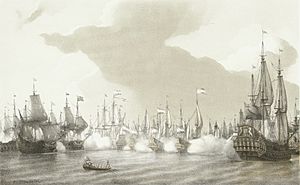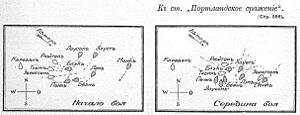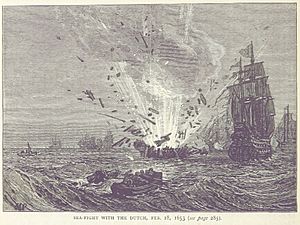Battle of Portland facts for kids
Quick facts for kids Battle of Portland |
|||||||
|---|---|---|---|---|---|---|---|
| Part of the First Anglo-Dutch War | |||||||
 |
|||||||
|
|||||||
| Belligerents | |||||||
| Commanders and leaders | |||||||
| Strength | |||||||
| 80 warships | 80 warships | ||||||
| Casualties and losses | |||||||
| 3 warships sunk | 12 warships sunk | ||||||
The naval Battle of Portland, also known as the Three Days' Battle, happened from February 18 to 20, 1653. It was a major fight during the First Anglo-Dutch War. The English fleet, led by Admiral Robert Blake, was attacked by the Dutch fleet. The Dutch fleet was led by Lieutenant-Admiral Maarten Tromp and was protecting many merchant ships. They were sailing through the English Channel.
This battle did not fully decide who controlled the English Channel. Both sides said they won. The real control of the Channel was decided later at the Battle of the Gabbard. That battle allowed the English to block the Dutch coast. This blockade lasted until the Battle of Scheveningen, where Admiral Maarten Tromp was killed.
Why the Battle Happened
Rivalry Between England and the Dutch Republic
The First Anglo-Dutch War started because England and the Dutch Republic (also called the United Provinces) were rivals. Both countries had strong navies. They both wanted to control the world's trade routes. For a long time, England and the Dutch Republic were seen as friends. They often worked together against the Habsburgs, a powerful European family.
Some people think the war might not have happened if King Charles I had stayed in power in England. He would not have had enough money from Parliament to start a war. But then, Oliver Cromwell and the English Parliament became very powerful. This made things worse between England and the Dutch. The Dutch leader, called a stadtholder, even supported the Royalists (King Charles's supporters) financially during the English Civil War.
Dutch Trade Grows Stronger
During the English Civil War, the Dutch took advantage of England's problems. They made their navy much bigger. They also expanded their trade all over the world. They even started to challenge England's control in its own colonies. The Dutch were very proud, saying they could drive all other nations off the sea. However, Cromwell did not challenge the Dutch right away. He was busy making sure his power was secure in England.
New English Laws and Actions
Things changed when Cromwell's armies finally defeated the Royalists. This ended the English Civil War. With Cromwell in charge, Parliament passed a new law in 1651. It was called the Navigation Act. This law said that all goods coming to English ports had to be carried by English ships. This hurt Dutch trade a lot. It cut them off from all of England's colonies.
Later that year, Parliament gave an order. It allowed English ships, including privateers (private ships allowed to attack enemy ships), to capture Dutch merchant ships. England also started to say it controlled the "British Seas." This meant the English navy had power from the North Sea all the way to Cape Finisterre in Spain. An English admiral named Sir George Ayscue showed this power. He brought Barbados under English control and captured 27 Dutch merchant ships.
Dutch Response and War Begins
The Dutch were not sure how to respond. Some Dutch leaders wanted to avoid conflict. But when talks failed and the Navigation Acts were passed, a group called the Orangists became more powerful. The Dutch government then decided to make their war fleet three times bigger. This fleet would protect Dutch interests. Admiral Maarten Tromp was put in charge of this new fleet. He was famous for defeating the Spanish fleet in 1639.
The Dutch also signed a treaty with Denmark. This was meant to hurt English trade routes. War finally broke out in May 1652. This happened after a fight between Admiral Robert Blake and Admiral Maarten Tromp at the Battle of Dover.
After some smaller fights, the two main fleets met for a big battle at Battle of Dungeness in November 1652. The English lost this battle. This made them rethink their naval strategy. English leaders, including Admiral Sir Henry Vane, developed a new tactic. This tactic would be very important for naval warfare for the next hundred years.
The English copied a Dutch idea. They organized their fleets into squadrons for better control. This new tactic was called the line-of-battle tactic. It meant ships would form a long line to fire their cannons. This tactic stayed key to English and British naval strategy until the end of the Second World War. The two fleets would soon meet again near Portland.
The Battle of Portland
First Day: February 28, 1653
In early February 1653, Admiral Tromp was guiding many Dutch merchant ships. He took them safely through the English Channel and into the Atlantic Ocean. He then anchored near La Rochelle to fix and resupply his ships. He was waiting for more merchant ships coming from the Atlantic.
On February 24, Tromp finally set sail with 152 merchant ships. Four days later, he reached the area off Portland. There, he saw Blake's English fleet trying to block them. Tromp immediately signaled for a general attack. He started the fight with the wind in his favor, which gave him an advantage.
Tromp's main ship, the Brederode, quickly met Blake's main ship, the Triumph. Tromp's ship fired its cannons from very close range. Then, it turned around and fired again from the other side of the Triumph. After turning again, it fired a third time. Blake's ship then moved away and decided to fight from a longer distance.
Dutch Commodore De Ruyter was able to attack the back of the English fleet. He fought against the largest English ship, the Prosperity. De Ruyter tried to board the Prosperity, but the English crew fought him off the first time. A second boarding attempt forced the Prosperity to surrender. English ships then tried to get the Prosperity back, surrounding De Ruyter. But after a tough fight, the Dutch commodore managed to escape. The battle continued all day with heavy firing from both sides. Later that day, Blake sent some fast ships to capture the Dutch merchant ships near La Rochelle. Tromp quickly sent his own captains to stop the English. Night finally ended the day's fighting.
Second Day: March 1, 1653
The next day, the English started the fight first. They had the wind in their favor this time. The English fleet tried five times to break through the Dutch line of ships, but they failed. During this day, 12 Dutch merchant ships were caught by Blake's fast ships. These merchant ships had tried to escape, even though Tromp had told them not to. After the second day, most of the Dutch warships had very little gunpowder and cannonballs left. There was no way to get more supplies.
Third Day: March 2, 1653
The third day ended the same way. The English still could not break the Dutch line. Several Dutch captains tried to run away because they had no ammunition left. But Tromp stopped them by firing warning shots across their ships. The battle for the day ended when Blake pulled his ships away. He had forced the Dutch to fight until they had only about half an hour's worth of ammunition left. Blake stopped fighting because he was wounded in the leg that day.
Fourth Day: March 3, 1653
On the fourth day, the English tried to start fighting again. But they found the sea empty of Dutch warships. Tromp had guided the rest of his fleet along the coastline. He escaped what would have been a certain defeat the next day. He left behind eight warships and a number of merchant ships. Both sides said they won the battle. However, it was Tromp who left the battlefield, not Blake. In the end, Blake was able to take 20 to 40 Dutch merchant ships and at least eight Dutch warships back to his home port.
What Happened After
The Battle of Portland helped England get back control over the English Channel. The Dutch tried to say the battle was a victory for them, or a "glorious defeat." People in the Netherlands publicly celebrated the bravery shown. But Admiral Tromp and his other officers knew the truth. They came home feeling very sad.
They realized that the English using the line-of-battle tactic made it impossible for the Dutch to win just by being better sailors. They told the Dutch government that they needed to start building very heavy warships. They couldn't just replace lost ships with armed merchant ships anymore. To try and keep the North Sea open for trade, a Dutch fleet that was not fully ready fought the English again at the Battle of the Gabbard.




